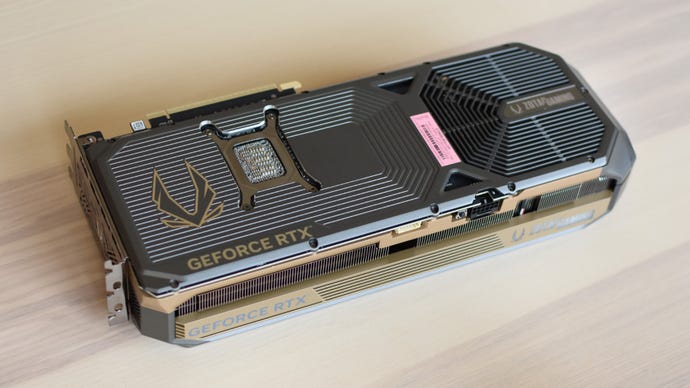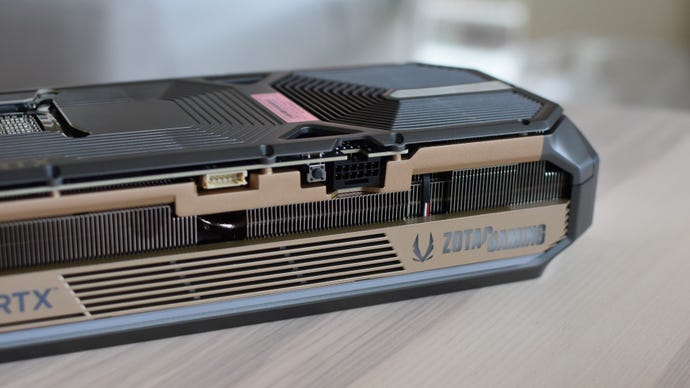I’m a bit late to the Nvidia GeForce RTX 5070 Ti, which means that this review – while already a dismal failure in the glowing robot eyes of the Internet nowness machine – can at least factor in the context of the GPU’s first few days on sale. Said context can be summarised thusly: Ah. Umm. Errrrrrrr.
No, early life has not been kind to the RTX 5070 Ti. Inadequate stocks and the lack of an Nvidia-made Founders Edition, unlike those of the RTX 5090 and RTX 5080, have cut the chances of finding one at the intended £729 / $749 RRP to pretty much nada. Not to mention how some models are shipping with missing render output units, potentially hurting performance. It’s a saddening start, made all the more unfortunate by the fact that the RTX 5070 Ti really isn’t a bad graphics card in itself.
If it were me, sure, I’d probably hold out for a base price model – the one I’ve been testing, Zotac’s GeForce RTX 5070 Ti AMP Extreme Infinity, ups itself to £910 / $930, with styling that’s slightly too ‘Decepticon’s lunchbox’ for my tastes. But within all that bulk is a GPU that can both eat max-quality 1440p alive and withstand the rigours of 4K, especially with the help of the DLSS 4 Multi Frame Generation (MFG) that the RTX 4070 Ti and RTX 4070 Ti Super miss out on.
Nvidia GeForce RTX 5070 Ti review: 4K benchmarks
To show what I mean, we return to the RPS test rig, which I’ve just updated with an AMD Ryzen 7 9800X3D (taking the place of the Intel Core i9-13900K). For the second time in 2025, this kills the comparison value of all previous GPU benchmark results – you’re welcome! – but the 9800X3D should prove the better option in time, especially for the 1080p and 1440p tests where it most comfortably beats the i9-13900K. Anyhow, look, graphs:
In addition to thumping the RTX 4070 Ti in relatively faster games like Shadow of the Tomb Raider and Metro Exodus, the RTX 5070 Ti also keeps its head much better in tricky ones like Cyberpunk 2077 F1 24. It’s actually knocking on the RTX 5080’s door in the latter, and is more or less neck and neck in Assassin’s Creed Mirage.
I didn’t have a handy RTX 4070 Ti Super to test with the new rig, though extrapolating from how it compared to the RTX 4070 Ti in previous tests, I’d be surprised if you wouldn’t still get double-digit framerate upgrades from all of these games outside Horizon Forbidden West. The RTX 5070 Ti also sticks with the last-gen Super version’s VRAM upgrades, and goes one step further by switching its 16GB of 256-bit memory to GDDR7. Definitely enough for 4K, in other words.

The RTX 5070 Ti is also more flexible with its frame generation. The usual disclaimers apply: Nvidia’s AI generated frames increase input lag rather than cutting it, so you should always ensure a stable base of traditionally rendered frames before trying frame gen. But that’s more attainable with the new model than it was on the RTX 4070 Ti – with upscaling, the RTX 5070 Ti can just about manage playable framerates with Cyberpunk 2077 and Alan Wake 2’s harshest settings, path tracing included.
Obviously, 4x MFG puts visual smoothness beyond anything the RTX 4070 Ti can hope for. What’s arguably more important, though, is that the older GPU falls short of 30fps, meaning it’s not suitable for running this calibre of quality settings with out without frame gen. The RTX 5070 Ti is.
Nvidia GeForce RTX 5070 Ti review: 1440p benchmarks
The RTX 5070 Ti also makes sense as a luxury 1440p driver. Although neither of its predecessors were lacking here, the new GPU still makes some sizeable gains, with Horizon Forbidden West and Total War: Warhammer III benefitting especially. There also looks to be plenty of headroom for more pixel-heavy ultrawide resolutions, like 3440×1440.
Without the added strain of 4K, the RTX 5070 Ti can also really start excelling with those difficult path tracing and ray tracing effects. Take Alan Wake 2: the RTX 4070 Ti is plenty playable here, averaging 45fps with the aid of Quality-level DLSS upscaling, but the RTX 5070 Ti’s 55fps is visibly slicker and slightly more responsive in the hand. Then, once again, MFG steps in to win the numbers game decisively.
The only real cause for pause here – not that you can simply hop on Ebuyer right now and rush your way to an RTX 5070 Ti purchase – is that it’ll be worth waiting to see how the incoming RTX 5070 compares, possibly as well as the AMD Radeon 9070 XT. The RTX 5070 Ti can evidently coast its way to smooth 1440p, though its close proximity to the RTX 5080 also makes me wonder if it might be more of a ‘budget’ (relatively speaking) 4K contender, with cheaper alternatives making for better value on Quad HD monitors. We’ll see.
Nvidia GeForce RTX 5070 Ti review: 1080p benchmarks
Unlike with the RTX 5080, I suspect there might be at least some maddened souls who’d consider an RTX 5070 Ti for humble 1080p. Thus, here’s a graph to show how silly that would be:
It’s not that the RTX 5070 Ti stops being faster than what came before – granted, with the aid of perhaps the most bottleneck-avoidant CPU on the planet – but when you get so far into the triple digits, numerical advantages cease to have the impact that they do below 120fps or so. Especially so, if you don’t have the kind of high-end monitor whose refresh rate is enough to keep pace with the frame output.
There are certainly much more efficient graphics cards for 1080p, with the RTX 5070 Ti being rated for 300W of max power drinkage and requiring at least a 700W PSU. 750W, in the case of this Zotac model, though at least it’s not an energy hog as a matter of course: I recorded it peaking at 253W, well shy of its official maximum, while running an intensive Cyberpunk 2077 session. I’ll also concede that one upside to its goliath dimensions is cooling performance, with the GPU temp only reaching 54°c under load. That’s positively icy by modern graphics card standards; the high-tech, dual-axial fan design of the RTX 5080 Founders Edition cooler could only keep its lid at 65°c.

For £729, you could chalk up the RTX 5070 Ti as another serviceable if rarely exciting Nvidia GPU. As we’ve seen, however, the problem is that you have about as much chance of getting this card for £729 as you do of buying Alexandra Palace for a tenner. And when actual prices are running so close to the entry level of the RTX 5080 – which, for all its own stock shortages, has a Founders Edition that is at least sold in theory for under a grand – then it’s fair to start asking questions. Questions like “Why should I not just get the 5080 instead?” and “How, Nvidia, did you forget what happened in 2020?”
While the RTX 5080 goes harder on PSUs, and doesn’t provide much meaningful extra oomph at 1440p, it is more generally futureproofed, with a marked 4K advantage that can be enjoyed today. At saner prices, the RTX 5070 Ti would still be more of a crowdpleaser, but there are clearly some kinks that need working out before it’s seriously worth your cash.
This review is based on a retail unit provided by the manufacturer.











Add comment